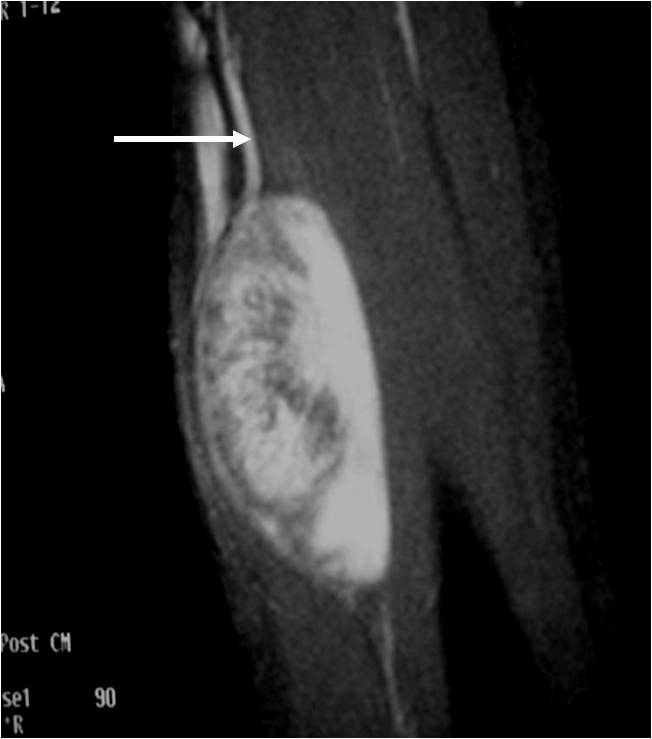What is Dedifferentiated Liposarcoma?
Dedifferentiated liposarcoma is the least common subtype of liposarcoma and usually arises from a well-differentiated liposarcoma. Progression occurs in 17 % of patients when well-differentiated liposarcoma is located in the retroperitoneum and 6% of cases when well-differentiated liposarcoma is located in the extremities. Dedifferentiated liposarcoma has also been defined as an atypical liposarcoma that progresses or changes over the course of time with variable histologic grade. This is essentially a low grade liposarcoma mixed with a high grade spindle cell sarcoma. These tumors occur mostly in adults and tend to grow more aggressively than a low grade well-differentiated liposarcoma. They arise most commonly in the retroperitoneum.
Who is usually affected?
- • The majority of cases occurs in individuals over the age of 50.
- • There is no gender predilection.
- • Accounts for about 18% of all liposarcomas.
- • Can progresses from well-differentiated liposarcomas (WDLPS) and their presentation is more frequent after a recurrence of WDLPS- Up to 17% of untreated, well-differentiated liposarcomas progresses to DDLPS.
Common Sites Involved
- • Retroperitoneum
- • Lower extremities
- • Upper extremities
- • Trunk
- • Can metastasize to lungs, liver, lymph nodes and other bones.
Signs and Symptoms
- • Signs and symptoms include pain and swelling.
- • Most patients present with an enlarging mass that can grow to a fairly large size.
Causes
- • Aside from the uncontrollable growth of abnormal cells to create a fatty mass, there is no known cause.
- • Can progress into dedifferentiated liposarcomas from well-differentiated liposarcomas.
Biological Behavior
- • Up to 17% of WDLPS progress to DDLPS.
- • DDLPS has 54-64% of overall survival and has 66 to 89% of disease-specific survival.
- • Progression to DDLPS occurs in 17% of the retroperitoneal WDLPS and 6% for the WDLPS in the extremities.
- • Location and mitotic count are the most important prognosis factors.
Diagnosis
- • The work-up for dedifferentiated liposarcoma often consists of a physical examination, X-ray, MRI, CT, and bone scans. Also, a bone scan, CT PET scan, and CT chest/abdomen/pelvis may be ordered to check if the tumor has spread, or metastasized, to the chest/abdomen/ pelvis or other parts of the body. The diagnosis is often confirmed with a biopsy, which samples the tumor for further analysis.
Risk to your limbs
Dedifferentiated liposarcoma is a malignant sarcoma that commonly occurs in the retroperitoneum, or the area in the back of the abdomen. Like all soft-tissue sarcomas, these liposarcomas grow in the soft-tissues of the extremities and compromise or destroy the affected soft-tissue and muscles. These tumors can compress or stretch important vessels and nerves, and occasionally wrap around these structures making it difficult to remove the mass without an amputation. They also have the potential to invade adjacent bones. Without treatment, dedifferentiated liposarcomas can metastasize or spread throughout the body, with the lungs, liver, and bones being the most common sites. Several risk factors include location and size of the sarcoma, and mitotic count.
Radiographic imaging is used to help form a diagnosis. These include X-Ray, MRI, CT and Bone Scans.
An example of an MRI is shown.

Treatment of Dedifferentiated Liposarcoma
The treatment of dedifferentiated liposarcoma includes surgical excision through wide or radical resections. Limb-sparing surgery is performed whenever possible, however if the tumor compresses, stretches, or is wrapped around vital nerves and vessels then an amputation may be performed. Additionally, radiation and/or chemotherapy is recommended as adjuvant treatment. Early diagnosis and treatment is beneficial, as there is a 15%-20% chance of metastasis without early and effective treatment.
Surgery
Surgical treatment includes wide or radical resections to remove the complete tumor and additional margins. The removal of additional, surrounding margins ensures that the tumor is completely removed and decreases the chances of the tumor coming back.
Chemotherapy
Chemotherapy is a systemic treatment option for some cancers, meaning the chemotherapy drugs travel throughout the body and can kill the cancerous cells that have metastasized, or spread throughout. Chemotherapy is used to treat cancer, control/prevent cancer from spreading, and ease the symptoms related to the cancer. There are various drugs used in chemotherapy, so the combinations of drugs administered and the number of cycles may differ between each person and tumor. Lastly, chemotherapy may be used in conjunction with other treatments, specifically local treatments such as surgery.
Radiation
Radiation is a treatment option for some cancers. Radiation therapy is a localized treatment that utilizes high-energy particles or waves to kill cancerous cells. Because radiation therapy is a localized treatment, it only affects the area in which it is set to target and therefore eliminates the risks of damaging healthy cells throughout the body. Not only is it used to treat cancer, but it can also decrease the chances of the cancer from recurring. Lastly, radiation may be used in conjunction with other treatments, such as surgery or chemotherapy, to treat cancers.






